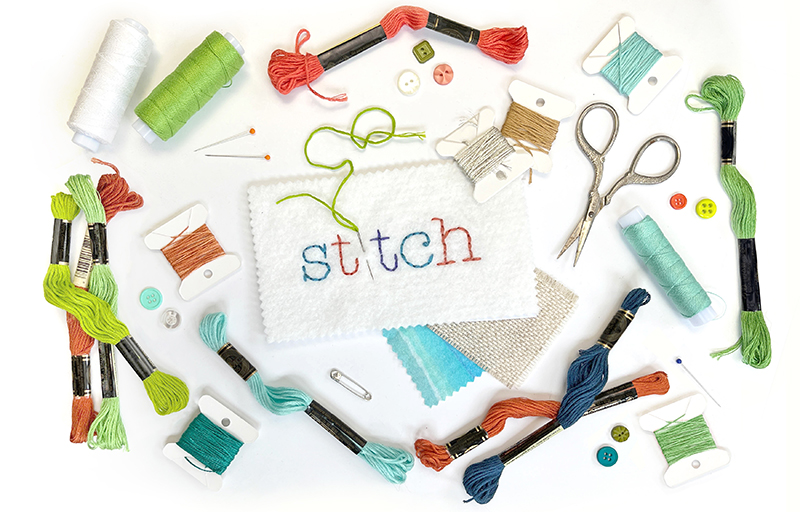
Threads
For class you can use either:
- 6-stranded cotton embroidery thread, commonly called “cross stitch floss”
- #8 perle cotton
How to choose your 6-stranded thread:
- Look for threads made by Anchor or DMC. Generic craft store versions aren’t the same and the thread tends to shred as you stitch.
- Avoid metallics. Variegated colors are fine.
- Thread is generally sold in a skein or spool. You can see both of those in the photo above.
- Choose 3-5 colors that have good contrast to the color of your fabric. You can use any colors you like.
- You can order threads directly from DMC or LoveCrafts (US and UK shops) or find them at Etsy or your local sewing or craft store.
How to choose perle cotton:
- Look for threads made by Wonderfil, Anchor or DMC. Generic craft store versions aren’t the same and the thread tends to shred as you stitch.
- Avoid metallics. Variegated colors are fine.
- Perle cotton is most often sold in a spool, but you can sometimes find skeins.
- Perle cotton comes in several sizes. Look for size 8 or 8/2 or #8. That’s the ideal size for this class.
- I love the “Sue Spargo collection” threads made by Wonderfil. You can find those here. They have some of the nicest variegated and ombre colors and they are really nice to stitch with.
- You can order threads directly from DMC or LoveCrafts (US and UK shops) or find them at Etsy or your local sewing or craft store.
- Choose 3-5 colors that have good contrast to the color of your fabric. You can use any colors you like.
Needles
For class you should have either:
- size 24 or 26 chenille needle
- size 7-10 embroidery needle
If you can’t find or don’t have those, look for a needle with a large eye and sharp point. As a rule of thumb, your needle wants to be about the same diameter as the thread you are using. Needles used for cross stitch and quilting/sewing won’t work for this class.
You can get needles from LoveCrafts (Us/UK) or DMC or John James Needles or Osborne needles from Cutex Sewing Supplies (my favorite) or find them on Etsy or at your local sewing or craft store.
Fabric
For class you should have:
- A small piece of fabric approximately 6×6 inches or 15×15 cm. The exact size is not important, but you should be able to hold it comfortably in your hand
- Choose either wool/rayon blend felt or woven mid-weight cotton (see below)
- It can be any color, but lighter colored fabrics with dark colored threads are probably easiest for beginners
- You can use new or recycled fabric
How to choose wool/rayon blend felt:
- This is my recommended fabric to learn to embroider on because it is easy to stitch and the thickness of the fabric really helps with your stitch tension
- You can also use 100% wool felt but it is more expensive (usually) and a little harder to find. Acrylic or polyester craft felt, sometimes also called “eco-felt”, is ok but can be more fragile and apt to tear and distort as you stitch.
- I get all of my felt from BenzieDesigns on Etsy. It’s my favorite and will be what I am using to demonstrate in class. They have choose-your-own-colors sets of 5 or 10 sheets of felt with matching 6-stranded floss, which is a great starter set of materials.
- Any color is great. I recommend light colors (with dark color threads) as the best for beginners.
How to choose a woven cotton:
- Choose a medium weight woven cotton similar to Kona Cotton Solids by Robert Kaufman or Petal Cotton Solids by Spoonflower.
- It should be a solid color. I recommend light colors (with dark color threads) as the best for beginners.
- You can use recycled fabric, but make sure it’s a medium weight woven fabric. T-shirt knits, denim, canvas, etc will not work.
Scissors
- Any pair of small sharp scissors will work. These ones by Fiskars are my favorites.

